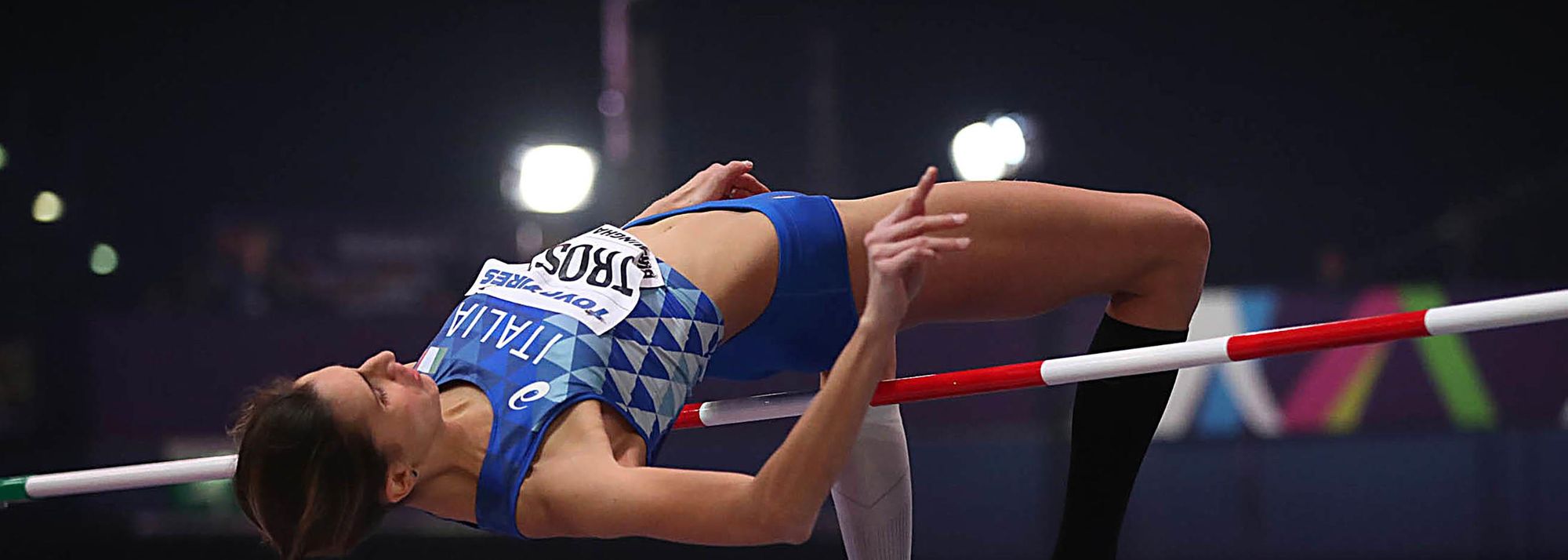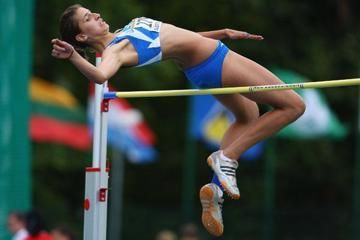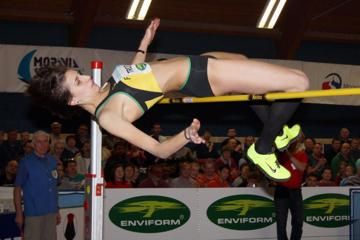Alessia Trost in Birmingham (© Giancarlo Colombo/FIDAL)
Alessia Trost punched the air and roared as she departed from the high jump matt. The Italian had just cleared 1.93m on the opening night of the IAAF World Indoor Championships Birmingham 2018 to effectively secure bronze. She had timed her best clearance of the indoor season to perfection, and the emotion showed exactly what it meant.
“Just those few centimetres put you in a different mood,” says Trost, who has had to wait longer than most anticipated to make it to a global medals podium on the senior stage. “It was kind of like a mental wall for me and I was happy that that wall went down in that moment. That was the right moment.”
Five years have passed since Trost sent a small shockwave through the high jumping world. Competing in Třinec, Czech Republic, the then 19-year-old recorded seven first-time clearances up to and including 2.00m to lead the global rankings.
Hitting a wall
No other woman would jump better in the 2013 indoor season; only four would better the mark outdoors all year – each her senior, each with Olympic or World Championships podium experience. A gold medallist at world U18 and U20 levels, Trost was duly heralded.
Yet while her contemporary Mariya Lasitskene --who had prevailed over the Italian at the 2010 Youth Olympics-- has progressed with unnerving precision in the intervening years, Trost hit a wall.
“I wasn’t comfy with myself in the last few years,” she admits. “I was still experiencing who I was. Maybe I was too young to jump that high.”
Although she won medals at age group and European levels, her marks dropped. Outdoors, her 1.98m SB in 2013 became 1.91m in 2014, and stayed at 1.94m each year through to 2017. Meanwhile, a global major champs medal continued to elude her.
“Frustrating” is how she describes those years. “It has been so hard to keep believing in what I was doing without having any results.”
A ‘fresh start’
She chose to overhaul her life after the Rio 2016 Olympics, where she could only get over 1.93m in the final for fifth.
“I decided to change my athletics life,” she says. “I changed my coach, I changed the city where I live, I completely changed technique. And really, I’ve started enjoying the journey more than I did before.”
Trost moved from her home of Pordenone, a city in the north east of Italy, to train in Ancona, in the centre, with 2016 world indoor champion Gianmarco Tamberi under the guidance of his father, Marco. The move was “a big motivation” for Trost.
“I felt like I was at my first day of elementary school,” she says. “That was the point when I started to say, ‘OK, I’m going to believe in this project, I’m going to believe in what I’m doing, I’m going to keep going with it and see if it works out’.”
Coping with tragedy
But the new start, far from home, did not come without challenges. At the end of 2016, Trost’s mother died. Soon after, her former coach, with whom she had trained for ten years, died. They were, Trost says, “hard times”, but also part of a process that has seen her make it to the global medals podium.
"I’ve come to know myself more, the good parts and bad parts,” she adds of the experience. “Now I know more clearly more clearly what I need to focus on.
“I have a new sense of myself. When I’m on the track, I’m no longer thinking about what people are thinking, what I’m supposed to do, what I should be doing or how high I should be jumping.
"I just think about what I’m doing. The stance, the speed, the approach. I found out that that is the thing I can rely on when I’m competing.”
Following Tamberi’s lead
There isn’t a turning point she identifies as being responsible for this shift in mindset. “I would say it was more about training. It was as much about living far away from my home town. I would say that it was growing up as a person.”
In training, Trost says she had the perfect example to follow in Tamberi, who was returning from an ankle ligament injury when they first started to work together.
“He looks like he’s a crazy guy, but he’s not,” she laughs. “He’s very meticulous in whatever he does. He trains so hard; he does everything he has to, as an athlete. His personal life is completely committed to the cause, so I’ve really learned to act this way.”
Trost also believes the Italian public, whose boisterous support always follows any of their home athletes, have become more sensitive to her challenges.
“When I jumped two metres I was on the newspapers everyday. It was a big pressure for me and I wasn’t able to cope with it,” she adds. “So these years, journalists, newspapers, and people, they have been understating my story, and I really appreciated it.
“Now that I’ve got this medal, we all know it’s not a high measure, but we’re all happy. I’m so happy that people are happy. I’m not jumping alone. I’m jumping with many people, for many people. And this is what I like about sport.”
The mark won’t create tremors like she did after Trinec, but the medal provides something Trost has been missing in the five years since: reassurance.
“1.93m is not a big height,” she admits, “but this is something that motivates me more to keep going: to keep believing in the project.”
Thomas Byrne for the IAAF







